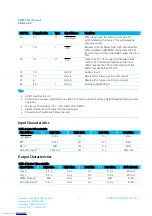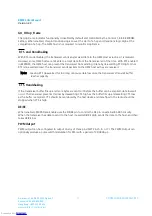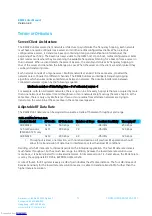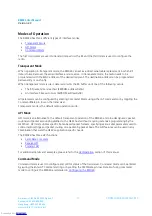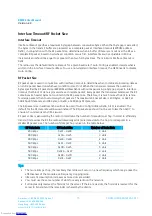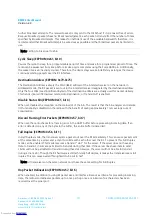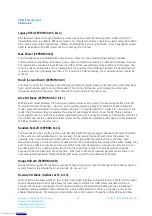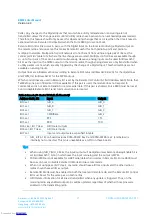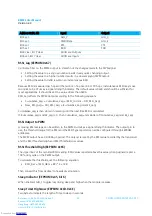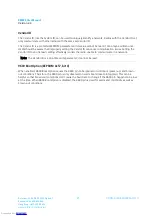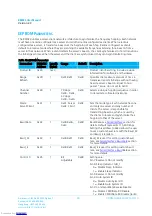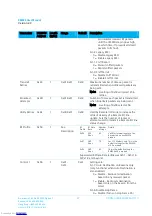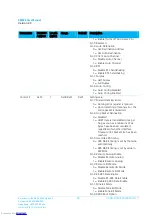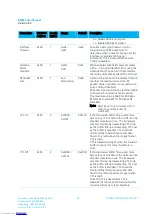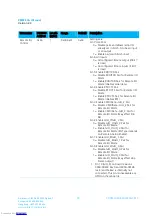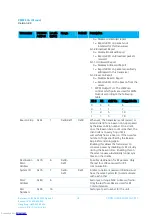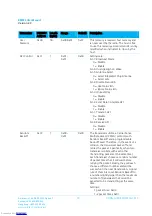
RM024 User Manual
Version 2.3
Americas: +1-800-492-2320 Option 2
Europe: +44-1628-858-940
Hong Kong: +852-2923-0610
www.lairdtech.com/wireless
18
CONN-GUIDE-RAMP24-0413
Auto Channel (EEPROM 0x56, bit 3)
To allow for more flexible network configurations, Auto Channel can be enabled in clients to allow them to
automatically synchronize with the first server they detect, regardless of channel number.
Note: A client with Auto Channel only synchronizes with a server that has a matching System ID.
Auto Config (EEPROM 0x56 bit 0)
The optimal settings for interface timeout and RF packet size vary according to the selected RF profile and
interface baud rate. Enabling Auto Config bypasses the value for these variables stored in EEPROM and uses
predetermined values that have been optimized for the given mode. When Auto Config is disabled, these
values must be programmed in the transceiver EEPROM.
Auto Destination (EEPROM 0x56, bit 4)
To simplify EEPROM programming, Auto Destination can be enabled in the radio which allows the radio to
automatically set its destination to the address of the radio from which it last received a successful
transmission from (beacon or data packet).
Auto Destination on Beacons Only (Address 0x56, bit 7)
When Auto Destination is enabled, the client radio addresses itself to the source of any received packet,
including beacons from the server and any addressed or broadcast packets it receives. For point to multipoint
networks where the client is intended to only communicate back to the server, this could cause the client to
inadvertently become addressed to another client. By enabling Auto Destination on Beacons Only, the client
only addresses itself upon reception of beacons, therefore it only addresses itself to the server. Auto
Destination on Beacons Only is only functional when Auto Destination is also enabled.
Auto System ID (EEPROM 45, bit 4)
When enabled, Auto System ID allows a client to attach to any server on the same RF channel, regardless of
the System ID on the server or the client.
Beacon Skip (EEPROM 0x6F)
When set, the transceiver will send (server) or listen (client) for a beacon on hops spaced by the Beacon Skip
number. On a client, once the Beacon Skip count is reached the client will listen every hop until it successfully
hears a beacon. It will then wait a number of hops specified by the Beacon Refresh before listening again.
Enabling this will allow the transceiver to conserve power by disabling its RF circuitry during the beacon time.
Enabling this on the server causes substantially longer sync times on the clients.
Broadcast (EEPROM 0xC1, bit 7)
In Broadcast mode, the transceiver transmits the packet to all transceivers with the same Channel Number
and System ID settings. There is no RF acknowledgement sent from the recipient(s) back to the transmitter,
therefore the packet is sent out the number of times specified by Broadcast Attempts.
Broadcast Attempts (EEPROM 0x4D)
When transmitting broadcast packets, the RF packet is broadcast out to all eligible receivers on the network.
Broadcast Attempts is used to increase the odds of successful delivery to the intended receivers. Transparent
to the OEM host, the transmitter sends the RF packet to the receivers. If a receiver detects a packet error, it
throws out the packet. This continues until the transmitter exhausts all of its attempts. Once the receiver
successfully receives the packet, it sends the packet to the OEM host. It throws out any duplicates caused by
Downloaded from
Downloaded from
Downloaded from
Downloaded from
Downloaded from
Downloaded from
Downloaded from
Downloaded from
Downloaded from
Downloaded from
Downloaded from
Downloaded from
Downloaded from
Downloaded from
Downloaded from
Downloaded from
Downloaded from
Downloaded from




